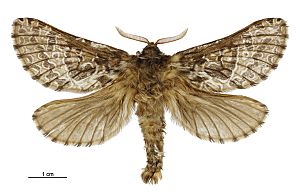Aoraia facts for kids
Quick facts for kids Aoraia |
|
|---|---|
 |
|
| Aoraia dinodes male | |
| Scientific classification |
|
| Kingdom: | Animalia |
| Phylum: | Arthropoda |
| Class: | Insecta |
| Order: | Lepidoptera |
| Family: | Hepialidae |
| Genus: | Aoraia Dumbleton, 1966 |
| Species | |
|
See text. |
|
| Synonyms | |
|
|
Aoraia is a group, or genus, of large moths. These moths belong to the family called Hepialidae. All 13 known species of Aoraia moths live only in New Zealand. This means they are endemic to New Zealand.
The first moth identified for this group was Porina dinodes Meyrick, in 1890. Some Aoraia moths are quite big! Their wingspan, which is the distance from one wingtip to the other, can be up to 150 mm. That's about the length of a large smartphone!
Discovering the Aoraia Moths
The Aoraia genus was first described by Lionel Jack Dumbleton in 1966. Scientists study these moths to learn more about New Zealand's unique wildlife. Understanding these moths helps us protect them and their habitats.
What are the Aoraia Species?
There are 13 different types, or species, of Aoraia moths. Each one is a unique part of New Zealand's natural world. Here are the known species:
- Aoraia aspina
- Aoraia aurimaculata
- Aoraia dinodes
- Aoraia ensyii
- Aoraia flavida
- Aoraia hespera
- Aoraia insularis – This species lives only on Stewart Island/Rakiura and the small islands nearby.
- Aoraia lenis
- Aoraia macropis
- Aoraia oreobolae
- Aoraia orientalis
- Aoraia rufivena
- Aoraia senex
The Mystery of Buller's Moth
One interesting moth is Buller's moth (Aoraia mairi). This moth might be extinct, meaning it no longer exists. We only know about one specimen ever found. It was collected way back in 1867. Sadly, this only known sample has been lost. Because of this, scientists are not completely sure about its description. It remains a mystery in the world of moths!

